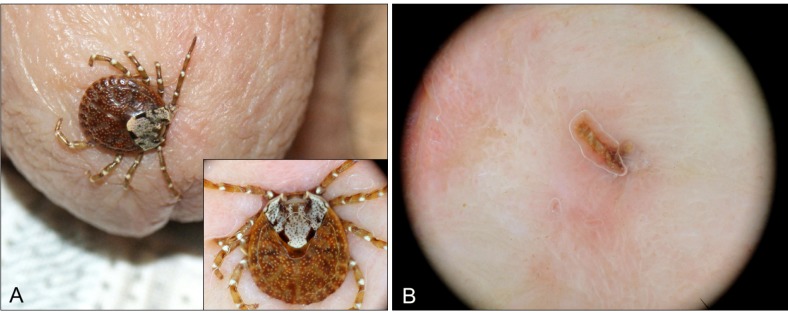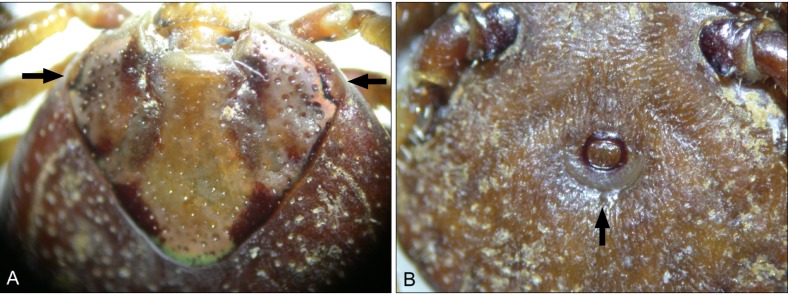Dear Editor:
Since the first report of a human tick infestation in 19821, about 40 human cases have been reported in the Korean literature. The causative ticks reported in Korea were 7 species, and tick bites from Amblyomma testudinarium has been reported once in Korea2. Dermoscopy is a useful technique that allows the visualization of magnified submacroscopic structures, and by using dermoscopy, we could identify the biting tick and detect the residual part of the tick.
A 75-year-old Korean man who lived in Tongyeong city, Gyeongsangnamdo, Korea presented with a small, blackish nodule on his glans penis (Fig. 1A). He had worked on a chili pepper farm the previous day. We noticed that the nodule was a tick by using dermoscopy and removed it with forceps. When we were removing the tick, the mouthpart of tick tore off. We identified the remaining part of the tick by using dermoscopy (Fig. 1B), and the tick bite site was excised. Histopathologic findings showed wedge-shaped necrosis at the site of penetration of the mouthparts, and remnants of the mouthparts of the tick.
Fig. 1.

(A) A tick attached to the glans penis. Inset: Dermoscopic findings revealed a female Amblyomma testudinarium. (B) Dermoscopic findings showed the remaining part of the tick.
The tick was examined stereoscopically and identified as a female A. testudinarium based on the morphological characteristics as described previously3. The tick was about 18 mm in length, having 4 pairs of legs. The dorsal scutum was seen as a small shield ornamented with dark brown spots. The eyes were located on the lateral edges of the scutum (Fig. 2A). An anal groove was observed on the posterior portion of the anus (Fig. 2B). The external spur of coxa I was longer than the internal spur of coxa I. A comma-shaped spiracular plate and genital aperture were seen on the ventral side.
Fig. 2.

(A) Dorsal scutum was seen as a small shield ornamented with dark brown spots. The eyes (arrows) were located on the lateral edges of the scutum (×25). (B) Anal groove (arrow) was observed on the posterior portion of the anus (×25).
Human tick bites by A. testudinarium have been reported mainly in regions with a warm and humid climate. In addition, A. testudinarium tends to attach to the axillary or inguinal region, which are rich in apocrine glands4. The reason why A. testudinarium prefers these sites is unknown, but it has been suggested that this tick reacts strongly to the odor from the apocrine glands. In our case, Tongyeong city is located in the southern coastal area of the Korean peninsula and has an oceanic climate. The external genitalia is rich in apocrine glands and blood supply, but the glans penis has no apocrine glands. As the patient's glans penis was not covered by a prepuce after a circumcision, we suggest that the patient's glans penis was easily approached by the tick.
The usefulness of dermoscopy for diagnosing tick infestations was proposed previously. Especially, dermoscopy can determine whether or not the tick has been completely removed5. In our case, we could identify the biting tick and easily made a preliminary identification of the species of the tick. We also detected the remaining mouthpart of the tick by using dermoscopy. When patients present with a small nodular lesion on the glans penis, dermoscopy can be a useful diagnostic tool.
In our report, A. testudinarium was identified stereoscopically. Furthermore, the dermoscopic findings helped to make a diagnosis and detect remnants of the tick. We report the second human case of a tick bite from A. testudinarium in Korea for which dermoscopy was used as an adjuvant diagnostic tool.
References
- 1.Kang WH, Chang KH, Chun SI, Koh CJ, Cho BK. A case of tick bite caused by Ixodes species. Korean J Dermatol. 1982;20:789–793. [Google Scholar]
- 2.Kim J, Joo HS, Moon HJ, Lee YJ. A case of Amblyomma testudinarium tick bite in a Korean woman. Korean J Parasitol. 2010;48:313–317. doi: 10.3347/kjp.2010.48.4.313. [DOI] [PMC free article] [PubMed] [Google Scholar]
- 3.Yamayguchi N, Tipton VJ, Keegan HL, Toshiocak S. Ticks of Japan, Korea, and the Ryukyu Islands. Brigham Yougn Univ Bull Biol Ser. 1971;15:1–226. [Google Scholar]
- 4.Yamada Y, Dekio S, Jidoi J, Isobe A, Shiwaku K, Yamane Y. A case of tick bite from Amblyomma testudinarium on the glans penis. J Dermatol. 1996;23:136–138. doi: 10.1111/j.1346-8138.1996.tb03986.x. [DOI] [PubMed] [Google Scholar]
- 5.Oiso N, Nakano A, Yano Y, Kawada A. The diagnostic usefulness of dermoscopy for identifying six-legged larval ticks. Ticks Tick Borne Dis. 2010;1:197–198. doi: 10.1016/j.ttbdis.2010.09.005. [DOI] [PubMed] [Google Scholar]


